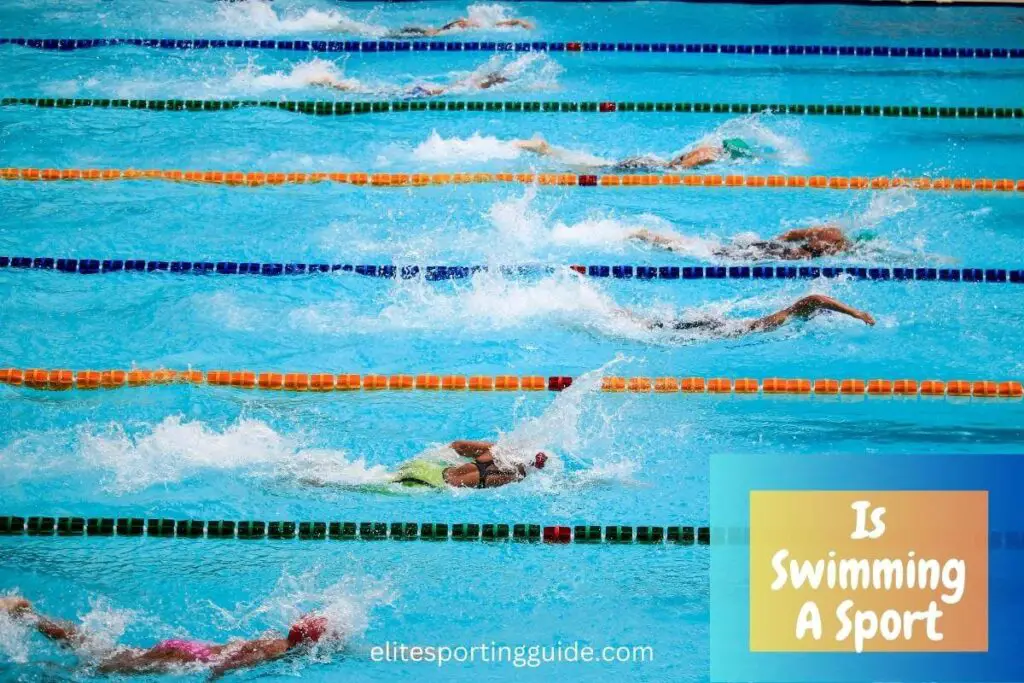The question of whether swimming qualifies as a sport may seem straightforward to some, but it’s a topic that often sparks debate.
In this article, we will look into the definition of a sport and explore how swimming fits within this framework.
We will examine the competitive nature of swimming, the physical demands it places on athletes, and its inclusion in major international sporting events such as the Olympics.
Is Swimming A Sport?
Yes, swimming is considered a sport. It involves competitive races and events where individuals or teams compete to achieve the fastest times or cover the longest distances in water, following established rules and regulations. Swimming is recognized as an Olympic sport and is practiced at various levels of competition worldwide.
Defining Sports: An Exploration of What Constitutes a Sport
Defining swimming as a sport involves considering several key criteria:
1. Competition: Swimming, like other sports, involves competitive events where individuals or teams aim to achieve the best time or distance in a controlled setting.
2. Physical Exertion: Competitive swimming demands a high level of physical exertion, with athletes requiring strength, endurance, and technique to perform at their best.
3. Rules and Regulations: Swimming has well-established rules and regulations governing race formats, stroke techniques, and conduct in competitions, ensuring fair play.
4. Organized Governing Bodies: There are governing bodies such as FINA (Fédération Internationale de Natation) that oversee and regulate competitive swimming events on a global scale.
5. Recognition: Swimming is recognized as an Olympic sport, participating in the highest level of international sporting competition, which further solidifies its status as a sport.
6. Training and Coaching: Competitive swimmers undergo rigorous training regimens, often under the guidance of coaches, emphasizing the athletic nature of the activity.
Physical Demands on Swimmers

Swimming places significant physical demands on athletes due to its unique combination of cardiovascular endurance, muscular strength, and technique. Some of the key physical demands on swimmers include:
1. Cardiovascular Endurance: Swimming requires exceptional cardiovascular endurance.
Athletes must maintain a high heart rate for extended periods while efficiently using oxygen to fuel their muscles.
Races can range from short sprints to long-distance events, each demanding a different level of endurance.
2. Muscular Strength: Swimmers need strong muscles to propel themselves through the water.
This strength is especially vital in strokes like the butterfly and freestyle, where swimmers use their upper body muscles for powerful strokes.
3. Core Stability: Core muscles play a crucial role in maintaining balance and stability in the water. A strong core is essential for efficient swimming and preventing injury.
4. Flexibility: Swimming requires a good range of motion in the shoulders, hips, and ankles to execute proper stroke techniques.
Swimmers often incorporate flexibility exercises into their training regimen.
5. Technique and Form: Achieving efficient stroke technique is essential to reduce drag in the water and maximize speed. Proper form also minimizes the risk of injury.
6. Mental Toughness: Competitive swimming can be mentally demanding, requiring athletes to stay focused, maintain a positive mindset, and push through physical fatigue and challenges in the water.
7. Recovery: Swimmers need to prioritize recovery through activities like stretching, massage, and rest to ensure their bodies can perform optimally during training and competition.
Overall, the physical demands on swimmers encompass a holistic approach to fitness, including endurance, strength, flexibility, and mental resilience, making it a physically demanding sport that requires a well-rounded training regimen.
Swimming in the Olympics: A Premier Stage for Athletic Achievement
Swimming has been a prominent and integral part of the Olympic Games since their modern revival in 1896. Here are some key points about swimming in the Olympics:
1. Historical Significance: Swimming was one of the original sports included in the first modern Olympic Games in Athens, Greece, in 1896. Since then, it has been featured in every subsequent edition of the Summer Olympics.
2. Events: The Olympic swimming program includes a variety of events, such as freestyle, backstroke, breaststroke, butterfly, and individual medley races for both men and women.
There are also relay events where teams of swimmers compete.
3. Records and Achievements: The Olympics have witnessed numerous iconic moments in swimming history, with legendary athletes like Michael Phelps, Ian Thorpe, and Katie Ledecky setting world records and achieving unprecedented success on the Olympic stage.
4. Global Participation: Swimming at the Olympics attracts participants from around the world, making it one of the most widely practiced and watched sports during the Games.
Countries compete for medals in swimming, and the competition often showcases emerging talents and established stars.
5. Swimming Venues: The Olympics feature state-of-the-art swimming facilities with world-class pools designed to meet international standards.
These venues are equipped to host both swimming and diving events.
6. Olympic Swimming Federation: The international governing body for aquatic sports, known as FINA (Fédération Internationale de Natation), is responsible for overseeing and regulating swimming competitions at the Olympics, as well as other aquatic events such as diving, water polo, and synchronized swimming.
7. Paralympic Swimming: Swimming is also a prominent sport in the Paralympic Games, where athletes with disabilities compete in various swimming events, showcasing their exceptional abilities and determination.
Post you may like: Is Swimming Cardio?
Is Swimming a Sport? Examining Contrasting Viewpoints
The debate over whether swimming should be classified as a sport involves contrasting viewpoints that revolve around several key arguments and perspectives.
Here are the main contrasting viewpoints:
Viewpoint 1: Swimming is Undoubtedly a Sport
• Competition: Proponents argue that swimming meets the fundamental criteria of a sport, as it involves competitive races where athletes strive to achieve the fastest times or cover the longest distances.
• Physical Demands: Supporters point out the rigorous physical demands swimming places on athletes.
It requires strength, endurance, and precise technique to excel, which aligns with the physicality expected in sports.
• Organized Governing Bodies: Swimming is governed by organizations like FINA, which establishes rules and regulations, conducts drug testing, and oversees competitive events, all hallmarks of a recognized sport.
• Olympic Recognition: Swimming is featured prominently in the Olympic Games, one of the most esteemed sporting events worldwide. Its inclusion in such events reinforces its status as a sport.
Viewpoint 2: Swimming is Not Necessarily a Sport for Everyone
• Recreational vs. Competitive: Critics argue that while swimming is a sport at the elite competitive level, it doesn’t fit neatly into the sports category for everyone.
Many people engage in swimming purely for leisure, relaxation, or fitness, which they perceive as distinct from competitive sports.
• Subjectivity: Some contend that the classification of a sport can be subjective and culturally influenced. In certain cultures, swimming might be considered more as a recreational or lifestyle activity rather than a sport.
• Differing Perceptions: Swimming’s status as a sport can vary based on regional and cultural differences.
In some regions, swimming may be more closely associated with daily life and leisure than with organized competition.
• Inclusive Definitions: Critics argue for more inclusive definitions of sports that encompass a broader range of physical activities, acknowledging that not all swimming necessarily fits the traditional competitive sports mold.
Post you may be interested in: Is Swimming A Good Exercise?
Swimming as a Lifestyle vs. Competitive Endeavor

Swimming is a multifaceted activity that can be pursued both as a lifestyle choice and as a competitive endeavor, with each path offering distinct benefits and experiences.
Distinguishing between recreational or lifestyle swimming and professional, competitive swimming helps to shed light on the diverse ways people engage with the sport.
1. Recreational Swimming as a Lifestyle:
For many, swimming is an integral part of a healthy lifestyle. Recreational swimming is embraced as a means of staying fit, relieving stress, and enjoying leisure time.
Individuals who choose swimming as a lifestyle often find solace and tranquility in the water, where they can escape the demands of everyday life.
The benefits extend beyond physical fitness, encompassing mental well-being and relaxation.
Recreational swimmers can savor the freedom of leisurely laps in the pool, the serenity of open water swims, or the camaraderie of aqua fitness classes.
Swimming as a lifestyle is about personal fulfillment, and participants set their own goals, whether it’s improving endurance, perfecting stroke technique, or simply finding joy in the water.
2. Professional Swimming as a Competitive Endeavor:
On the other end of the spectrum lies professional swimming, where athletes commit themselves to a rigorous and competitive pursuit of excellence.
Professional swimmers dedicate countless hours to intense training, guided by expert coaches, with the goal of reaching the highest echelons of the sport.
This level of commitment often involves rigorous physical conditioning, strict dietary regimens, and mental preparation to perform at the highest level.
Competing at national and international championships, such as the Olympics, World Championships, and major swimming meets, becomes the pinnacle of their career.
Professional swimmers chase records, medals, and the opportunity to represent their countries on the world stage.
Their dedication and sacrifice are testament to the immense challenges and rewards of this competitive endeavor.
3. The Intersection and Benefits of Both:
What makes swimming unique is the fluid transition between these two worlds.
Many professional swimmers started as recreational swimmers, discovering their passion for the sport in local pools or during family vacations.
Likewise, recreational swimmers often find inspiration in watching elite athletes and may set new fitness goals or join masters swim programs.
Benefits of Recognizing Swimming as a Sport: Implications for Funding and Support
Recognizing swimming as a sport has several benefits, particularly in terms of implications for funding and support:
1. Increased Funding Opportunities: When swimming is officially recognized as a sport, it becomes eligible for financial support from various sources, including government sports ministries, national and international sports associations, and private sponsors.
This funding can be used to enhance training facilities, provide financial assistance to athletes, and support grassroots development programs.
2. Athlete Development: Official recognition as a sport often leads to increased investment in athlete development programs.
This can include coaching, training camps, and talent identification initiatives. As a result, the overall talent pool grows, and the quality of athletes improves.
3. Infrastructure Development: With recognition, there is a stronger case for investing in swimming infrastructure, such as state-of-the-art pools and aquatic centers.
This not only benefits elite athletes but also promotes the sport at the grassroots level, encouraging more people to take up swimming.
4. Exposure and Sponsorship: Sports that are officially recognized tend to attract more media attention and sponsorship opportunities.
High-profile events and athletes in recognized sports receive more exposure, which can lead to increased financial support from corporate sponsors.
5. Inclusion in Education: Official recognition can lead to swimming being included in school and college curricula.
This ensures that young athletes have access to proper coaching and facilities, nurturing talent from a young age.
6. International Participation: Recognition allows swimmers to represent their countries in international competitions, such as the Olympics and World Championships, which can further boost their profiles and attract more financial support.
7. Improved Governance: Recognition often comes with governance structures and regulations that help ensure fair play, athlete safety, and doping prevention, all of which contribute to the overall integrity of the sport.
The Verdict on Swimming’s Status as a Sport
In conclusion, the evidence overwhelmingly supports the classification of swimming as a sport.
From its competitive nature with races and records to the rigorous physical demands it places on athletes, swimming aligns with the core characteristics that define a sport.
Its inclusion in the Olympics, as well as the presence of organized governing bodies like FINA, further solidifies its status within the global sporting community.
While there may be occasional debates or alternative viewpoints on this matter, the overwhelming consensus in the athletic world recognizes swimming as a sport.
It boasts a rich history, a thriving competitive scene, and a community of dedicated athletes who embody the principles of sportsmanship, discipline, and dedication.
The recognition of swimming as a sport not only brings it under the umbrella of official sporting activities but also opens doors to funding, development, and opportunities that benefit athletes, fans, and the sport as a whole.



